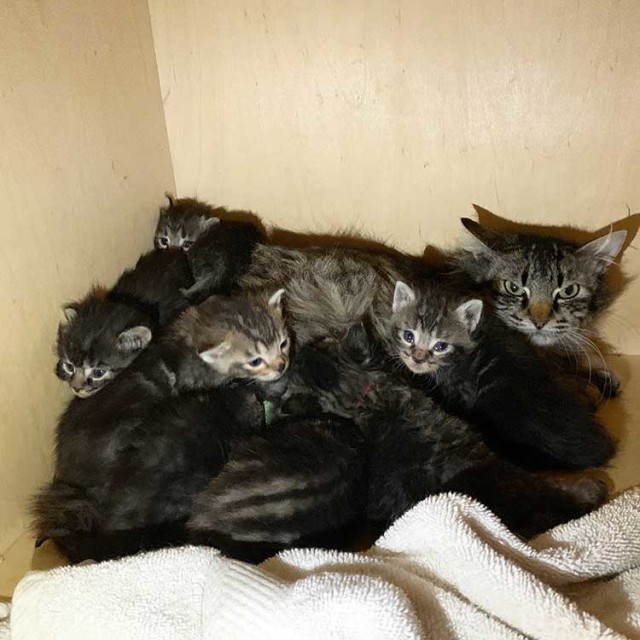When San Francisco SPCA volunteer Amy Jones attended the June 20 hearing of the Animal Welfare Commission regarding the SPCA’s controversial new feral cat program, she had no intention of speaking. That’s because the SPCA had told volunteers not to do so. Then the SPCA used a photo of a mother and kittens she had fostered as an example of how cruel it was to keep mother cats in captivity.
“They said she was kept in a cage — she was not, she was in a condo [with a] whole room to herself — and that she was highly stressed. In reality, she was totally fine. She took amazing care of her seven babies, and none of them, including her, got sick,” Jones wrote in an email. “She looked stressed in the photo they showed because I had a camera in her face … I was so mad.”
Jones attached two nanny cam videos showing the family in her care. The mother grooms her kittens, comes out of the crate to eat, and grooms her kittens some more (watch the videos at marinatimes.com). She’s not the wild, stressed-out beast the SPCA claimed; in fact, she appears calm and content.
In an email to Jones dated June 21 (the day after the hearing), SPCA director of volunteer services Liora Kahn attempts damage control. “When we asked volunteers not to speak at the meeting it was not to censor anyone and was not meant to be a threat against anyone’s volunteer status,” Kahn said. “Our reason for asking volunteers not to speak were based [on] our efforts to build a new relationship with the SFSPCA cat trapping team based on mutual trust, respect, and understanding.”

The SFSPCA used a misleading photo of a feral cat family at a hearing of the Animal Welfare Commission to bolster a new policy for leaving them outside.
That’s ironic, considering the SPCA implemented their new plan (“Leaving feral kittens outside longer is a bad idea,” Marina Times, Sept. 2019) with zero input from those volunteers or local rescue groups. Instead, they say they based their decision on a study by Dr. Kate Hurley of the UC Davis Koret Shelter Medicine Program — a person who admitted to killing cats she deemed feral as a Santa Cruz animal control officer in the 1990s.
To further prove how much they trust and respect their volunteers, the SPCA went all the way to Maryland to get input from the divisive “advocacy group” Alley Cat Allies. A 2018 exposé of Alley Cat Allies by journalist Marc Gunther highlighted widespread violations of tax law, a negligent board of directors that hadn’t met once that year, and funds siphoned toward nonmission oriented purchases — like real estate for founder Becky Robinson.
Give Me Shelter Cat Rescue, an all-volunteer San Francisco nonprofit founded in 2003, runs on a bare-bones budget of $150,000 annually, with veterinary costs eating up $86,000 (contrast that to the SPCA’s net assets of over $81,700,000). Lana Bajsel, Give Me Shelter’s founder, says the new policy is a slap in the face. “They never conferred with us — the people sitting outside at 2 a.m. trying to trap a mom with eight kittens running around. They just implemented this policy without our input, based on fraudulent data by people who haven’t done the work.”
Bajsel says cat mortality rates in the wild are incredibly high. “They face cars, predators, disease; the moms can get killed and the kittens are left. Moms also move their kittens frequently. The longer you leave them out there, the harder they are to catch. Now you have the kittens breeding and you can’t find them.”
As far as stress goes, Bajsel says it’s all relative. “When the mom is in a safe foster environment and doesn’t have to leave kittens three to four hours scrounging for food, that’s a lot less stressful. Are they unhappy being in a cage at the shelter for a few weeks? Yeah. That’s stressful for any cat, period. But it’s a small price to pay to raise kittens that are adopted and the entire family gets spayed and neutered. I just picked up a cat that wouldn’t let me near him. Now he follows me around and is on me like a cheap suit. [The SPCA] is making these broad decisions, but many of these cats aren’t feral, they’re abandoned.”
In one case, the SPCA decided to return a 3-year-old black cat named Shelby to the parking lot of Safeway on Market Street. “They wouldn’t give her to us,” Bajsel says. “She wasn’t going back to a colony — she was tame. We had to do a clandestine meeting with the trapper, like a drug deal, to get the cat.” And thanks to San Francisco’s devoted cat volunteers, Shelby, like so many others, has been adopted into a loving home.
Nanny cam videos of the same feral cat family taken by their foster mother showed they were happy and content inside:
E-mail: [email protected]. Follow the Marina Times on Twitter @TheMarinaTimes and like us on Facebook @MarinaTimes.




